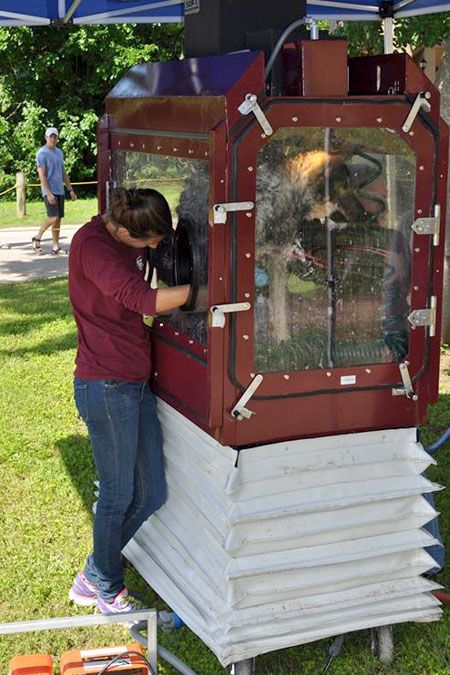Texas A&M Veterinary Emergency Team aids search and rescue efforts after floods
Team grateful for community support as it cares for animals in need.

As Texas Task Force 1 continued operations in Wimberley, Texas, Phreedom, a search and rescue canine belonging to Task Force member Ronnie Perry, made a visit to the Veterinary Emergency Team on May 27 to have a minor injury evaluated. Photo courtesy of the Texas A&M Veterinary Emergency TeamThe Veterinary Emergency Team at Texas A&M University was deployed in late May to aid search and rescue efforts after flooding in Texas. At the request of the National Urban Search and Rescue Team, Texas Task Force 1 (TX-TF1), which deployed May 24 to Wimberly, Texas, the veterinary emergency team deployed to care for TX-TF1's search and rescue dogs.
TX-TF1 demobilized May 29, but Texas Task Force 2 (TX-TF2) was called to mobilize and also requested the Veterinary Emergency Team to deploy with them to nearby San Marcos, Texas. Although a few members of the emergency team have rotated out, the core group has been in the flood-ravaged region for almost two weeks.
Angela Clendenin, director of communications for the Texas A&M College of Veterinary Medicine, says it rained in Wimberly almost every day of the deployment. The conditions were rough for search and rescue teams and the dogs. "There was debris and mud-water that's not exactly clean," she says. The emergency team made sure to hydrate the dogs and perform regular exams to keep them in operation.
The team has also been presented with animals in need of care by local animal control officers and citizens-including a screech owl and a rabbit. Clendenin says the most touching rescue was finding the McComb family's dog, which was caught in a tree in Wimberly. Laura McComb, 34, and her son Andrew, 6, were killed when Blanco River floodwaters washed away their house on Memorial Day. Leighton McComb, 4, remains missing. Jonathan McComb, Laura's husband and Andrew and Leighton's father, survived but suffered a collapsed lung, broken rib and shattered sternum. "Right now he's very much in shock, but he expressed his gratitude to the team for finding his dog," Clendenin says.
The team was also able to save a cat brought to them by a woman who had lost everything in the flood. When the cat arrived, Clendenin says, it was on "death's door." After 24 hours of treatment, the cat was doing well and the owner cried tears of joy, saying, "You saved my baby."
"In addition to caring for these highly trained dogs, at the same time we've been able to touch the lives of the animals here," Clendenin says. Plus, she continues, the team has made strong connections with local veterinarians and the community. "The amazing generosity and concern for us is overwhelming," she says.
People have been bringing food and donating items the team needs, Clendenin says. "They're asking, 'What can we do for you?' and we're here to help them on the worst day of their lives," she says. "It' been an incredible, humbling experience."
The environmental conditions and length of service have made this deployment different from others, Clendenin says. For one thing, most past deployments have been no more than two days. Plus, "the environment these search dogs are working in-they've absolutely needed us,” Clendenin says. “We've had some minor injuries."
In fact, the Texas Task Force, coordinated by the Federal Emergency Management Agency (FEMA), believes its dogs are able to stay in operation 50 percent longer with the onsite veterinary care provided by the Veterinary Emergency Team. "What that means is that they can save lives faster," Clendenin says. "It's hard, it's tough, but Aggies have always been devoted to selfless service. We're committed to staying here until they tell us they're done."
The 12- to 17-member team, the majority made up of Texas A&M veterinarians and technicians, plus three to five veterinary students, has families and coworkers pulling double duty in their absence. "Our college and our dean are 110 percent behind what we're doing," Clendenin says. "We couldn't do this if it wasn't for the support of the dean and our families."
To learn more about the Veterinary Emergency Team, go to its website and keep track of the deployment on the team's Facebook page.

After a long day of search and rescue in flood-ravaged San Marco, Texas, Lexi, a German shepherd, arrives at the VET base of operations to get the dirt and debris rinsed off of her before getting an end-of-day exam. C. J. Mabry of the VET designed this unique decontamination unit that the team is able to take on deployment to ensure that search and rescue canines and rescued resident animals are contaminant free prior to going to a shelter, home with their owners, or back with their handlers. Photo courtesy of the Texas A&M Veterinary Emergency Team